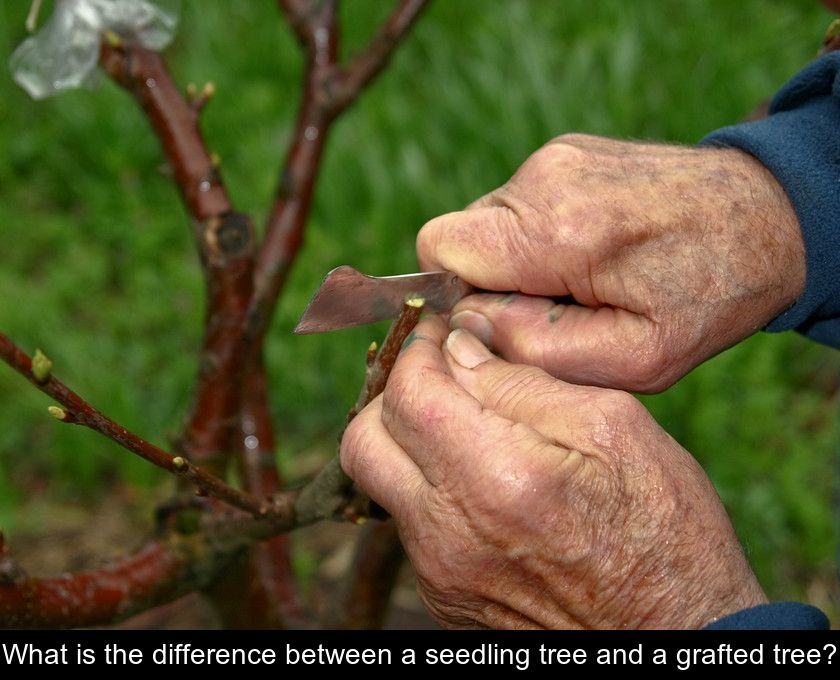What Is The Difference Between A Seedling Tree And A Grafted Tree?
The fruit trees found in garden centers are systematically grafted. But do you know why this operation is necessary and what is the difference between a rootstock tree and a grafted tree? We offer you to understand everything about tree grafting in 5 questions.
What is a franc tree?
In gardening, a wild tree is called a tree that comes directly from the sowing of a seed, a pip, or a stone.
Most wild trees are wild trees that reproduce by sowing.
2- What are the advantages and disadvantages of free-standing trees?
The culture of free trees is cheaper since it is not necessary to buy the plant from a nursery. It is enough to sow them.
When they are sown in place, these trees develop a significant root system that anchors them firmly in the soil and allows them to fetch water from deep below.
They are vigorous, resistant to drought, and can live long and healthy lives.
But a free tree also has disadvantages. First, it does not adapt to all types of soil, with some fruit trees having an aversion to overly wet, calcareous, or dry soils.
Furthermore, reproducing a species through sowing results in a tree with random physical characteristics. With this method, you are not sure to obtain the same flower color or the same taste quality of the fruits.
Therefore, it is a major drawback if you wish to multiply a beautiful ornamental tree or a fruit tree whose production you appreciate.
3- What is the purpose of grafting a tree?
The interest of grafted trees is to provide solutions to the problems posed by non-grafted trees.
Unlike a non-grafted tree, a grafted tree retains the ornamental and gustatory characteristics of the original variety as it is a clone of that variety.
Furthermore, a grafted tree can thrive on any type of soil and resist certain diseases if the rootstock is well chosen. The choice of rootstock even allows for determining the height of the tree in advance.
4- What is grafting a tree?
The grafting method is a technique commonly used to reproduce fruit trees such as cherry trees, apple trees, or pear trees, for example.
Grafting involves joining two plants: the rootstock and the scion. It is sufficient to take a small part of the tree that one wishes to reproduce, for example a branch with a few buds, to obtain the scion (also sometimes called a bud). It is this branch that the gardener wants to see develop in order to harvest its fruits.
The branch must then be grafted onto another tree called the rootstock. It can be a free-standing tree as this type of rootstock is appreciated by gardeners for its vigor.
In theory, the rootstock should be of the same species as the scion. But it is also possible to use a closely related species botanically. For example, one can graft a pear tree onto a quince tree or a peach tree onto a plum tree.
5- How to graft a tree?
To succeed in grafting between two plants, it is important to:
• choose the rootstock carefully.
• choose the grafting technique based on the species to be reproduced and the timing of the graft.
As for the rootstock, it is important to select a vigorous tree that is suitable for the local soil and climate, and has a well-developed root system as it will nourish the scion.
Regarding the technique to use, there are different types:
• budding grafting performed in spring so that the grafted branch can develop during the year.
• dormant bud grafting performed in summer so that the branch can develop the following year.
It is recommended to use:
• budding grafting for stone fruits such as peaches, apricots, plums, and cherries.
• V-grafting for stone fruits as well.
• cleft grafting for pome fruits such as apples and pears.
• crown grafting to rejuvenate an old fruit tree, but not for stone fruit trees.
• whip and tongue grafting with a rootstock and scion of the same diameter.
When the graft takes, it results in a more resistant tree, well adapted to the soil, which will produce earlier, higher quality fruits and in larger quantities.
In conclusion, it is not without reason that fruit trees are now systematically grafted. This particular technique requires learning and some equipment, but it brings









